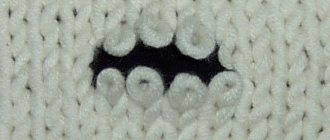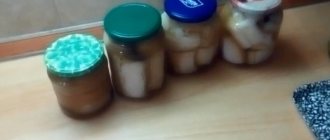Any hole, even in a visible place, can be sewn up or disguised so that nothing will be noticeable. A small tear (for example, from a cat's claw) is closed as if it were not with a hidden seam. You won't be able to sew up a large hole; decorative tricks will come to the rescue. Luckily, embroidery, patches and studs are back in fashion.
Invisible darning
On any clothing, but especially on knitwear, a tiny hole can appear out of nowhere and ruin the whole look. Most often they are discovered after washing. The thing is good, but you can no longer wear it, what should you do?
To prevent the hook from increasing in size, we will try to sew it up so that it is not visible. If you start working with simple threads, you can pull the material together and this place will catch your eye.
Let's not rush.
- Take the thinnest needle, the one used by bead embroiderers.
- Find tights that match the color of your T-shirt or are neutral.
Stages of work:
- Pull the thread out of the tights.
- Thread the needle using a threader. Don't tie a knot!
- We work from the front side of the product. Carefully collect all the loops with a needle. We catch them from below and from above, one loop at a time, then make a stitch without pulling the fabric.
- After finishing the darning, bring the needle to the wrong side.
- Secure the thread with a couple of stitches, then cut it off.
- Let's straighten the fabric and iron the repair area from the inside out. The nylon thread will melt slightly under the influence of high temperature, thereby closing the hole.
Mending clothes with needle and thread
The longitudinal hole can be easily darned using a primitive seam by hand. To do this, fold the edges from the wrong side and fasten them “forward with a needle.” Additionally, we sew a seam “over the edge” and fasten the thread to a knot. Snake sewing imitates machine stitching. This is how they fix things that have come apart at the seams. It is very convenient to mend a hole in a sock and tights with a “snake”.
What to do with things that have a hole in the most visible place? There are several tricks that will quickly return the fabric to its proper appearance.
Knitwear
Small holes sometimes appear on knitwear items, in inconspicuous places or in a visible area. Often such defects appear on T-shirts, T-shirts, shorts, sweatpants and leggings after machine washing.
They can be easily repaired using circular sewing, and no one will notice anything:
- We take the thread exactly in the color of the fabric.
- We pass each loop in stitches, moving in a circle and tightening the thread. We work on the wrong side and constantly check how the fabric looks on the front side.
- The hole will gradually close.
- Don't forget to fasten the thread from the wrong side so that the seam does not tear.
The same method is used to repair a woolen sweater, jacket, or pullover.
Another example of darning to hide a round hole on a thin knitwear item:
- We take out the thin nylon thread from the unnecessary tights.
- We pry up the loops from the front side and fasten them with thread without tightening the fabric.
- We finish sewing from the inside out and secure the thread with a knot.
- Iron the darning area with a hot iron. The nylon thread will melt a little and close the defect.
Knitted products have holes in the seam area, especially under the armpit: holes form there at an angle, and it is no longer possible to sew them with a standard machine stitch.
- We prepare a thin hook and threads for knitting, similar in thickness and color to the fabric of the item.
- We hook a loop and pull it through the adjacent one.
- At the end, we secure everything with a thread using a needle.
Jeans
Jeans often fray between the legs from frequent wear and washing. You can sew this place up unnoticed by simulating weaving threads in the fabric.
It's better to use machine stitch:
- Turn your pants inside out.
- First, we stitch the torn part along several lines, then we do the same across. The threads should form a dense mesh. On the front side, this work is very similar to the structure of denim.
If the jeans fabric is damaged in a non-critical area, such as on the leg or pocket, then try perforating it. If necessary, make the cut wider, pull out the longitudinal threads and rub the edges with sandpaper to make them fluffy.
Outerwear
It is better to entrust massive products to the atelier workers, since it is impossible to do without ripping out the lining. It’s especially offensive when an expensive fur coat suffers. Holes in the fur appear mainly on the sleeves, in the armpit area. To fix the defect, you will need a fur-colored thread, instant glue and a medical bandage.
Repairing things without a needle
It's sad when you find a small hole in your T-shirt. The T-shirt can be thrown away, or better yet, repaired. We still have time to throw it away!
- Spread the product on a smooth surface. From the “web”, cut out 2 squares of the same size, but larger than the hole on the clothing.
- Trim the corners.
- Place them together with the smooth shiny sides facing out, placing them “inside” the T-shirt under the hole.
- Use your fingers to connect the edges of the hole.
- Iron with an iron at medium heat. Ironing time is approximately 30 seconds.
- After the work is completed, the item can be worn again.
This method is not suitable for silk or wool items.
There won’t be a trace left on a knitted T-shirt if you do the following:
- Turn the product inside out.
- Bring the edges of the hole together.
- Place fabric gluing tape on it and interlining on top.
- Place a small piece of white fabric on top of all this so that the structure does not move.
- Spray the fabric with a spray bottle. Then place the heated iron in place of the patch and hold for 10 seconds.
- Remove the fabric and turn the product inside out.
Five simple options
There are no identical tears, damage to clothing, or holes, and there are many options for how to beautifully sew them up with embroidery. It is better for beginning craftswomen to use simple ones first.
Fantasy approach
If the location of the hole allows, you can not cover it with a patch or embroidery, but turn it into a decorative element. We give it the correct round shape, we process the edges manually with a buttonhole or overcast stitch (over the edge).
When processing the edges, we place the stitches as close to each other as possible so that the fabric does not unravel under the load when wearing the item. You can reinforce them with adhesive-based interlining or thin braid.
After the hole is processed, we add decor around it - we embroider flowers, stars, geometric shapes.
Bright rectangles
You can beautifully sew up a hole in jeans using a technique that imitates patchwork sewing.
Draw a rectangle or square on the fabric around the damaged area. You can draw with chalk or a dried bar of soap with sharp edges, or a thin felt-tip pen to match the fabric. Within the framework of the resulting figure, we lay a base-mesh, preferably diagonally. Then we lay another layer of thread across the stitches already made, bringing the needle alternately from above and from below, sometimes catching the fabric of the item.
A scattering of sparkling beads
On a T-shirt or knitted sweater or skirt, you can beautifully sew up a hole with beads. Such embroidery does not necessarily have to have a clearly defined shape. Let go of your imagination and create.
First, select a base - beads of different shapes, but of similar shades, so that the picture does not hurt the eye. The color should also match the color of the fabric on which it will be sewn. A sharp contrast will not only not smooth out the defect, but may even emphasize it.
Small colored elements
Do you have experience with cross stitch or satin stitch? Great! For those who are trying their hand at darning or decorating items from their wardrobe, this is an excellent opportunity to beautifully sew up several small holes that are often left by moths.
“Scatter” small cheerful spots all over your dress, leggings, turtleneck or even children’s tights. They can be monochrome or several shades. The main thing is that they echo each other.
How to repair a sock
This problem is familiar to every housewife.
Stages of work:
- After threading the needle, tie a knot. From the front side, pass the needle inside out to leave a knot there.
- When sewing up a hook, grab all the loops from one edge and the other.
- When finished, pull the thread so that it is hidden in the seam without being pulled out. Pull the seam slightly to the sides to straighten the thread. Pass the needle inside out and secure the thread.
Blind seam
An indispensable technique for repairing textile products. Ultimately, the seam will be invisible and differ little from a machine one.
To make a blind hem:
- Thread the needle and tie a knot.
- Pass the needle through the wrong side so that the knot is not visible.
- Connect the edges of the hole with a stitch and stretch the thread.
- Tighten so as not to deform the fabric.
- Bring the needle inside out again and make a knot. This method is suitable for completing any work on a hole.
Repair of thick knitwear
The demonstrated method is suitable for any item made of thick knitwear, including woolen socks.
Operating procedure:
- Turn the item inside out. Place small stitches on the needle across the direction of the threads in the product. Move up and down, stitching all the way to the end of the hole.
- Use the same stitches along the direction of the threads, intertwining them with the stitches already laid, grabbing a little of the material itself.
- Secure the thread with small stitches and then cut it off.
Plastering
This method is good mainly for thick, dense fabrics. To work, you need to select a patch exactly according to the size of the hole; the fabric should be as similar as possible to the main one in color, density, pattern and other characteristics. The product is fixed on thick fabric, the patch is inserted into the hole and leveled. The stitches go either to the main fabric or to the patch in accordance with the pattern. At the end, you need to iron the damp fabric from the back and front sides.
How to raise the eyelets at the seam
Stages of work:
- Using a crochet hook, pick up the loops.
- Gather with a safety pin.
- Close them with a hook, pulling one loop through the other.
- Secure the last one with thread.
- Sew up the hole with the same thread.
If a hole appears like in the picture below, then take tone-on-tone threads.
- Pick up the loops with a crochet hook.
- Assemble the loops according to the pattern shown in the picture. For clarity, a thread of a contrasting color was taken.
- Having collected the runaway loops, bring the thread to the wrong side, pass it between the loops, as in the photo. Remove all scraps inside out.
Holes in bed linen
Holes may appear in the center of the sheet as it wears out. It will not be possible to sew them up effectively, since the tissue in this place is thinned and prone to new damage.
You can restore the product by cutting it in half and sewing the edges together. Hem the new edges.
- Tears in your favorite things are not always a reason to say goodbye to them.
- There are many ways to discreetly, beautifully and originally disguise damage.
- You just need to prepare the necessary materials and work a little.
Depending on the nature of the damage, the type of fabric and the purpose of the product, you can easily make repairs and breathe a second life into your item.
Three ways of darning
This method is suitable for repairs in inconspicuous places.
Darning pattern in the classic way:
Before starting work, run a thread around the hole to prevent the fabric from stretching. After work it will need to be pulled out.
You can mend it unnoticed in this way:
Stretch auxiliary threads, then lay them with a thread that matches the color of this product.
For knitwear, the following repairs are suitable:
First, the thread is laid along the threads of the fabric, and then the darning itself is done.
To beautifully repair any item, try these options.
Instead of a hole, a decorative decoration appears. First, ordinary darning is done, and then a kind of embroidery is done.
The next option is to glue adhesive material from the inside, then do embroidery on it. Or you can make a patch on the “web”, glue it, then do embroidery on it.
These options are suitable for the most experienced dressmakers.
Leaves using Brazilian technique
Often the fabric is not torn, but frayed, and such a hole can be decorated using the Brazilian leaf embroidery technique. By the way, it is applicable for restoring any things - this way you can sew up a leather jacket, jeans and even tights. The result is not only beautiful, but also original.
There are two options for creating such a patch decoration. The first one is with a “flying” stitch. We fix the previously damaged area with a patch on the wrong side. Then, in the area of the fabric tear, draw a leaf and mark its middle. You can start decorating:
The second option is to use a fishbone suture. As in the first option, we fix the hole with a patch and draw a sketch of a leaf indicating the middle. Then we make stitches from the edge of the figure to the middle, with each of them slightly extending beyond the line.
How to mend jeans
If your pants are leaky, the easiest option is to make an appliqué.
For men - made of leather or denim material, and for women - the flight of imagination is not limited.
You can also watch a video on how to mend a small hole:
In parting: now all things will be saved, because there are many ways to sew up a small hole in any clothing.
Read further:
How to carefully and discreetly sew a jacket by hand and on a sewing machine
How to sew jeans between your legs discreetly and accurately, by hand and by machine
How to beautifully and accurately sew jeans at the knee by hand and on a machine
How to arrange a small kitchen yourself
How to use old tights: what you can make useful and beautiful with your own hands
What is a wish fulfillment card and how to make it work
Beautiful patches
If a small hole is easy to eliminate using ordinary methods, then with a large defect you will have to use your creative abilities. The easiest way to carry out repairs is with thermal stickers. They are sold at any craft store.
Various decorative stickers are selected according to the style of clothing. By the way, this way you can not only mask damage, but also create original clothes. For children's dresses there are patches with hearts, for boys' T-shirts and pants - with images of cartoon characters.
Bursting upholstery on a sofa or chair seat is also masked with patches. You won’t be able to sew up holes on the thinnest tulle unnoticed, but thermal stickers with floral patterns, butterflies, etc. will come to the rescue.
Important The patch should not only completely cover the hole, but also extend beyond its edges. This guarantees the integrity of the product.
Do not rush to get rid of the product if its defect can be repaired. A neat stitch or a beautiful appliqué will bring the item back into service.
Sooner or later, every person faces the problem of things with holes, including knitwear.











